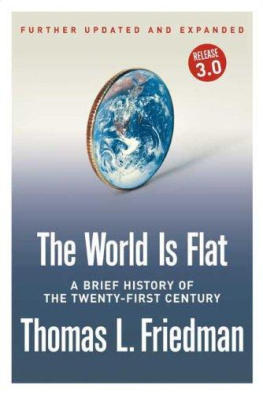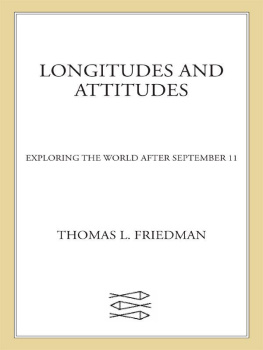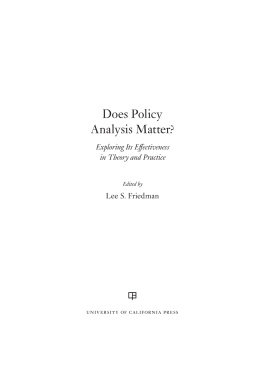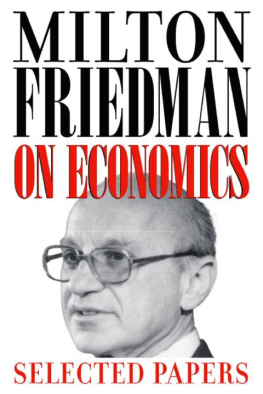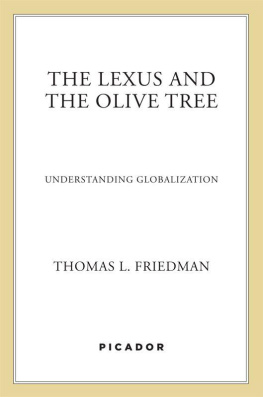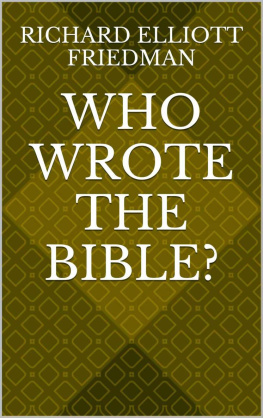
Thomas L. Friedman has won the Pulitzer Prize three times for his work at The New York Times, where he serves as the foreign affairs columnist. He is the author of three previous books, all of them bestsellers: From Beirut to Jerusalem, winner of the National Book Award for nonfiction; The Lexus and the Olive Tree: Understanding Globalization; and Longitudes and Attitudes: Exploring the World After September 11. In 2005 The World Is Flat was given the first Financial Times and Goldman Sachs Business Book of the Year Award, and Friedman was named one of Americas Best Leaders by U.S. News & World Report. He lives in Bethesda, Maryland, with his family.
ALSO BY THOMAS L. FRIEDMAN
From Beirut to Jerusalem (1989)
The Lexus and the Olive Tree (1999)
Longitudes and Attitudes (2002)
THE WORLD IS FLAT
THOMAS L. FRIEDMAN
THE WORLD
IS FLATA Brief History of
the Twenty-first Century FURTHER
UPDATED AND EXPANDED

THE WORLD IS FLAT . Copyright 2005, 2006, 2007 by Thomas L. Friedman. All rights reserved. Printed in the United States of America. No part of this book may be used or reproduced in any manner whatsoever without written permission except in the case of brief quotations embodied in critical articles or reviews. For information, address Picador, 175 Fifth Avenue, New York, N.Y. 10010.
www.picadorusa.com
Picador is a U.S. registered trademark and is used by Farrar, Straus and Giroux
under license from Pan Books Limited.
For information on Picador Reading Group Guides, please contact Picador.
Phone: 646-307-5259
Fax: 212-253-9627
E-mail:
Grateful acknowledgment is made to the following for permission to reprint excerpts of their work: the Associated Press; Business Monthly; BusinessWeek; City Journal; Discovery Channel / Discovery Times Channel; Education Week, Editorial Projects in Education; Fast Company / Mansueto Ventures; Forbes; New Perspectives Quarterly; John Seigenthaler; the International Finance Corporation and the International Bank for Reconstruction and Development / World Bank; and YaleGlobal Online ( http://yaleglobal.yale.edu/ ). Excerpts from articles from The Washington Post are copyright 2004. Reprinted with permission.
Book design by Jonathan D. Lippincott
Library of Congress Control Number: 2007929112
ISBN-13: 978-0-312-42507-4
ISBN-10: 0-312-42507-4
First edition published in 2005 by Farrar, Straus and Giroux
First updated and expanded edition published in 2006 by Farrar, Straus and Giroux
First Picador Edition: August 2007
1 3 5 7 9 10 8 6 4 2
To Matt and Kay
and to RonContents
Introduction to the
Paperback Edition
Why go through all the trouble of writing a second expanded and updated version of The World Is Flat only a year after the first expanded version was published and a mere two years after the original? I can offer a very brief answer: because I could and because I had to. Precisely because of the powerful technological forces detailed in this book, the publishing industry has sped up and it is now possible to revamp a whole book relatively easily. That is what I mean when I say I could. The reason I must do it is fourfold. First, the forces flattening the world didnt stop when the first edition of this book was published in April 2005, and I wanted to keep tracking them and weaving them into my overall thesis. Second, I wanted to answer one of the questions I was asked most often by parents while I was traveling around the country to speak about the book: Okay, Mr. Friedman, thank you for telling us that the world is flatnow what do I tell my kids? In the 2.0 edition, I added a lot more material on the subject of what is the right education to access the new middle-class jobs, and I have added still more in this 3.0 edition. Third, I found many of the comments from readers and reviewers both thoughtful and useful, and I wanted to absorb some of the best of them into the book. And finally, in this 3.0 edition, I have added two new chapters to deal with themes related to the flat world that were not apparent to me before but now seem extremely important. One deals with how to be a political activist and social entrepreneur in a flat world. The other deals with a more troubling phenomenonhow we manage our reputations in a world where we are all becoming publishers and therefore all becoming public figures.
This book has triggered a cottage industry of articles with variations on the title The World Is Not Flat. I have two reactions to these: (1) No kidding. (2) Whenever you opt for a big metaphor like The World Is Flat, you trade a certain degree of academic precision for a much larger degree of explanatory power. Of course the world is not flat. But it isnt round anymore, either. I have found that using the simple notion of flatness to describe how more people can plug, play, compete, connect, and collaborate with more equal power than ever beforewhich is what is happening in the worldreally helps people who are trying to understand the essential impact of all the technological changes coming together today. Not only do I make no apologies for it, I think that with every passing year, it becomes more true and more useful in explaining in a simple way what is happening. My use of the word flat doesnt mean equal (as in equal incomes) and never did. It means equalizing, because the flattening forces are empowering more and more individuals today to reach farther, faster, deeper, and cheaper than ever before, and that is equalizing powerand equalizing opportunity, by giving so many more people the tools and ability to connect, compete, and collaborate. In my view, this flattening of the playing field is the most important thing happening in the world today, and those who get caught up in measuring globalization purely by trade statisticsor as a purely economic phenomenon instead of one that affects everything from individual empowerment to culture to how hierarchical institutions operateare missing the impact of this change.
At some point I will stop writing this book. But for now, I am just enjoying the chance to keep sharing what I am learningand am thankful that the flattening of the world makes doing so easier than ever.
Thomas L. Friedman
Washington, D.C.
April 2007
How the World
Became Flat
ONE
While I Was Sleeping
Your Highnesses, as Catholic Christians, and princes who love and promote the holy Christian faith, and are enemies of the doctrine of Mahomet, and of all idolatry and heresy, determined to send me, Christopher Columbus, to the above-mentioned countries of India, to see the said princes, people, and territories, and to learn their disposition and the proper method of converting them to our holy faith; and furthermore directed that I should not proceed by land to the East, as is customary, but by a Westerly route, in which direction we have hitherto no certain evidence that anyone has gone.
Entry from the journal of Christopher Columbus on his voyage of 1492
N
o one ever gave me directions like this on a golf course before: Aim at either Microsoft or IBM. I was standing on the first tee at the KGA Golf Club in downtown Bangalore, in southern India, when my playing partner pointed at two shiny glass-and-steel buildings off in the distance, just behind the first green. The Goldman Sachs building wasnt done yet; otherwise he could have pointed that out as well and made it a threesome. HP and Texas Instruments had their offices on the back nine, along the tenth hole. That wasnt all. The tee markers were from Epson, the printer company, and one of our caddies was wearing a hat from 3M. Outside, some of the traffic signs were also sponsored by Texas Instruments, and the Pizza Hut billboard on the way over showed a steaming pizza, under the headline Gigabites of Taste!
Next page
